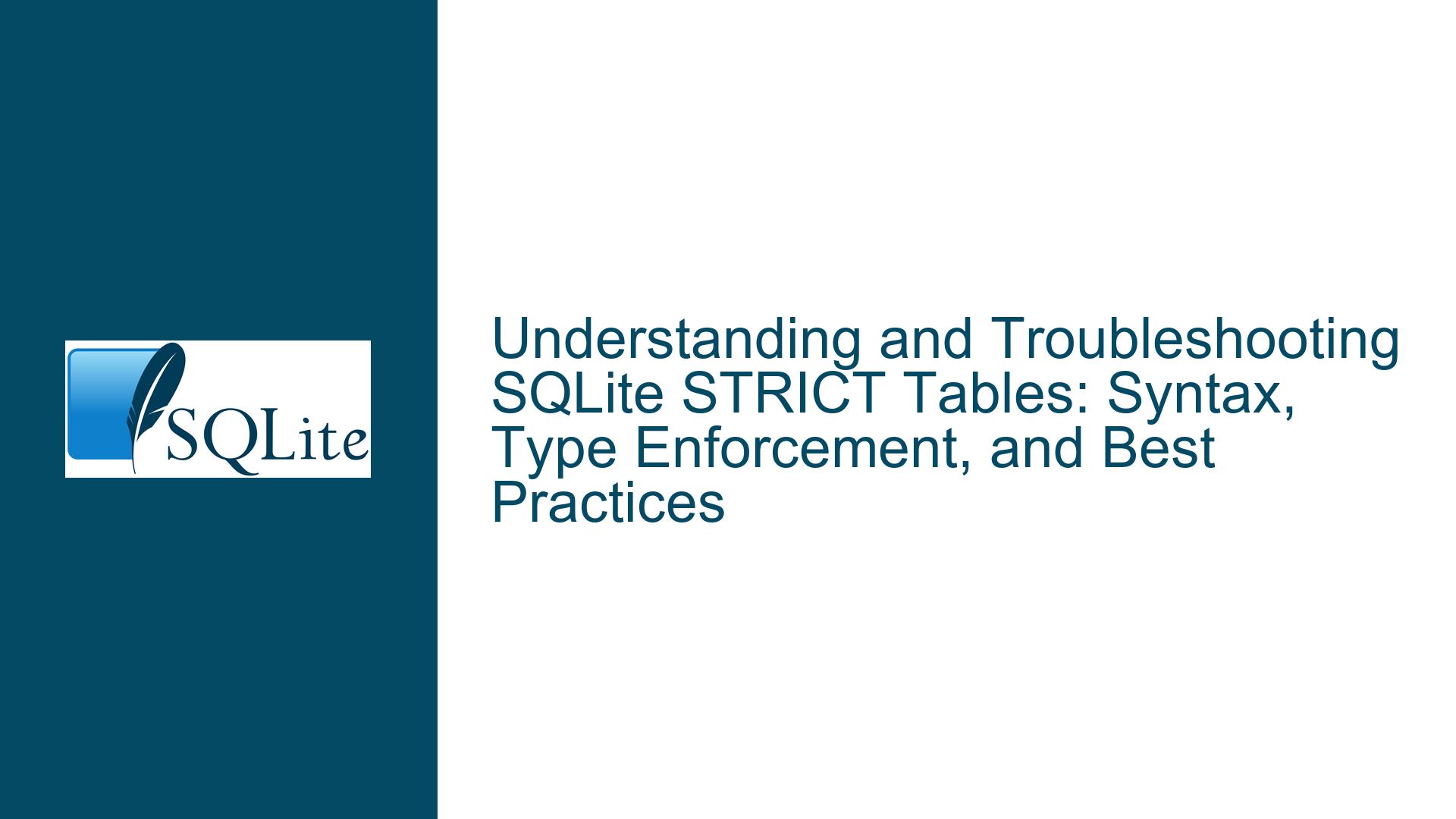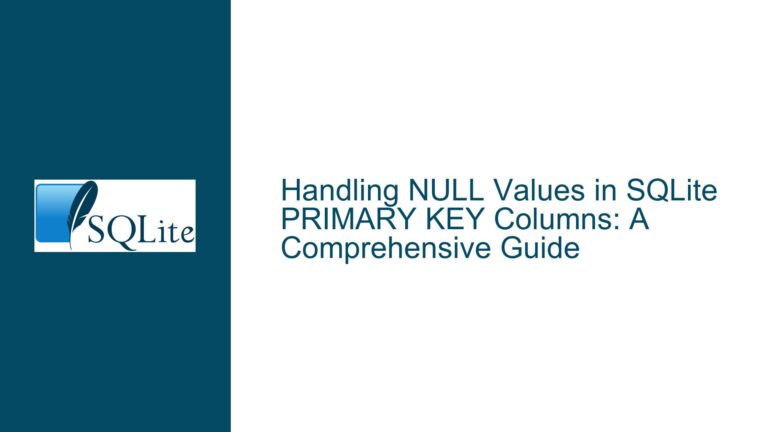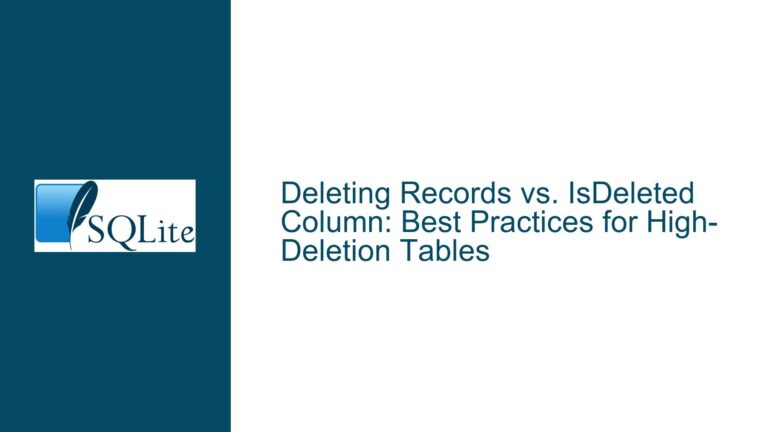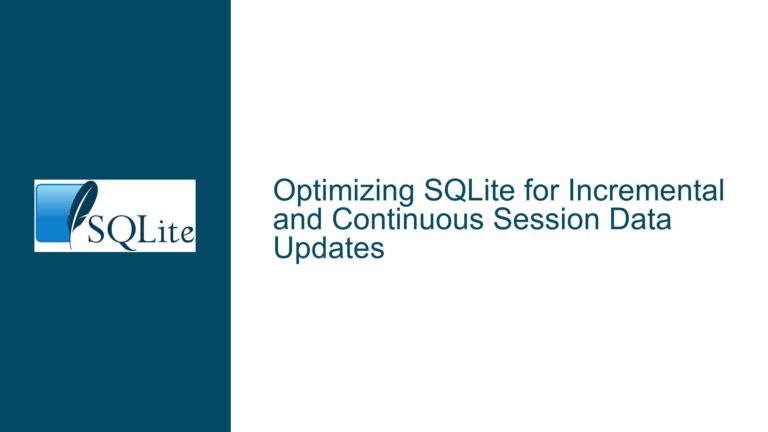and Troubleshooting SQLite STRICT Tables: Syntax, Type Enforcement, and Best Practices
Issue Overview: STRICT Table Syntax and Type Enforcement in SQLite
SQLite’s introduction of STRICT tables represents a significant evolution in its schema design capabilities, aiming to enforce stricter data typing and schema definitions. This feature is designed to address long-standing issues with SQLite’s flexible type system, where any column can store any type of data regardless of its declared affinity. While this flexibility has been one of SQLite’s strengths, it has also led to potential data integrity issues, especially in applications requiring rigorous type enforcement.
The core issue revolves around the syntax and semantics of STRICT tables, particularly how they handle type enforcement, column definitions, and the implications for existing SQLite practices. The discussion highlights several key points of confusion and concern:
- Syntax Placement of the STRICT Keyword: The placement of the STRICT keyword at the end of the CREATE TABLE statement, rather than immediately after the CREATE keyword, has raised questions about readability and potential oversight during schema design.
- Type Enforcement and Compatibility: The distinction between INT and INTEGER types, the absence of the ANY type in the draft documentation, and the handling of type decorations (e.g., INTEGER(3)) have caused confusion. Users are uncertain about how STRICT tables will enforce these types and whether legacy practices, such as using type decorations for compatibility, will still be supported.
- Global vs. Local STRICT Enforcement: There is a debate about whether STRICT mode should apply globally to all tables in a database or only to those explicitly declared as STRICT. This has implications for database migration and consistency.
These issues are not merely syntactic but touch on deeper questions about SQLite’s design philosophy, backward compatibility, and the practical challenges of adopting stricter schema enforcement in a database known for its flexibility.
Possible Causes: Why STRICT Tables Are Challenging to Implement and Understand
The challenges surrounding STRICT tables in SQLite stem from a combination of historical design decisions, user expectations, and the inherent tension between flexibility and rigidity in database systems.
- Historical Design Decisions: SQLite’s type system has always been dynamically typed, allowing any column to store any type of data. This design choice has made SQLite highly adaptable but has also led to potential data integrity issues. The introduction of STRICT tables represents a shift toward stricter typing, which conflicts with some of SQLite’s foundational principles.
- User Expectations and Legacy Practices: Many SQLite users have developed practices and tools that rely on its flexible type system. For example, using type decorations like INTEGER(3) for compatibility with other SQL databases is a common practice, even though SQLite does not enforce these decorations. The introduction of STRICT tables disrupts these practices, requiring users to rethink their schema designs.
- Syntax and Readability Concerns: The placement of the STRICT keyword at the end of the CREATE TABLE statement, rather than immediately after the CREATE keyword, has raised concerns about readability and the potential for oversight. This syntax choice may lead to errors in schema design, particularly in large or complex databases where the STRICT keyword might be overlooked.
- Global vs. Local Enforcement: The question of whether STRICT mode should apply globally or locally reflects a broader debate about how to balance consistency and flexibility in database design. Global enforcement would ensure consistency across the entire database but might make migration more challenging. Local enforcement allows for a more gradual transition but could lead to inconsistencies if not managed carefully.
These causes highlight the complexity of introducing stricter schema enforcement in a database system that has historically prioritized flexibility and ease of use. Addressing these challenges requires careful consideration of SQLite’s design principles, user needs, and the practical realities of database migration and maintenance.
Troubleshooting Steps, Solutions & Fixes: Navigating STRICT Tables in SQLite
To effectively troubleshoot and resolve issues related to STRICT tables in SQLite, it is essential to adopt a systematic approach that addresses both the technical and practical aspects of the problem. Below, we outline a series of steps, solutions, and fixes that can help users navigate the challenges of STRICT tables.
Understanding the Syntax and Placement of the STRICT Keyword:
- Review the Documentation: Begin by thoroughly reviewing the official SQLite documentation on STRICT tables, paying close attention to the syntax and placement of the STRICT keyword. This will help clarify the intended usage and avoid common pitfalls.
- Use Linting Tools: Consider using SQL linting tools or IDE features that highlight schema definitions and flag potential issues, such as the placement of the STRICT keyword. These tools can help ensure that the keyword is not overlooked during schema design.
- Adopt Consistent Formatting: Develop a consistent formatting style for CREATE TABLE statements that includes the STRICT keyword. For example, always place the STRICT keyword on a new line or in a prominent position within the statement to improve readability and reduce the risk of oversight.
Handling Type Enforcement and Compatibility:
- Clarify Type Definitions: Ensure that all column types in STRICT tables are explicitly defined and adhere to the allowed types (INT, INTEGER, TEXT, etc.). Avoid using type decorations like INTEGER(3), as these are not supported in STRICT tables.
- Migrate Legacy Schemas: If migrating from a non-STRICT schema, carefully review and update column definitions to comply with STRICT table requirements. This may involve converting type decorations to appropriate types or adding constraints to enforce data integrity.
- Use PRAGMA Statements: Leverage SQLite’s PRAGMA statements to enforce stricter type checking and validation across the database. For example, PRAGMA strict=ON can be used to enable strict mode globally, ensuring consistent behavior across all tables.
Deciding Between Global and Local STRICT Enforcement:
- Evaluate Database Requirements: Assess the specific requirements of your database and application to determine whether global or local STRICT enforcement is more appropriate. Consider factors such as data consistency, migration complexity, and the potential impact on existing queries and applications.
- Implement Gradual Migration: If opting for local enforcement, develop a migration plan that gradually introduces STRICT tables into the database. This approach allows for testing and validation while minimizing disruption to existing workflows.
- Monitor and Adjust: Continuously monitor the performance and behavior of STRICT tables after implementation. Be prepared to adjust the schema or enforcement settings as needed to address any issues that arise.
Best Practices for Using STRICT Tables:
- Document Schema Changes: Maintain detailed documentation of all schema changes, including the introduction of STRICT tables. This documentation should include the rationale for each change, the expected impact, and any potential risks or considerations.
- Test Thoroughly: Conduct thorough testing of STRICT tables in a development or staging environment before deploying them to production. This testing should include data migration, query performance, and application compatibility.
- Educate Team Members: Ensure that all team members involved in database design and maintenance are familiar with the principles and practices of STRICT tables. Provide training and resources to help them understand the implications and benefits of stricter schema enforcement.
By following these steps and adopting best practices, users can effectively navigate the challenges of STRICT tables in SQLite and leverage their benefits to improve data integrity and consistency. While the transition to stricter schema enforcement may require careful planning and adjustment, the long-term advantages of reduced data errors and improved query performance make it a worthwhile investment.






